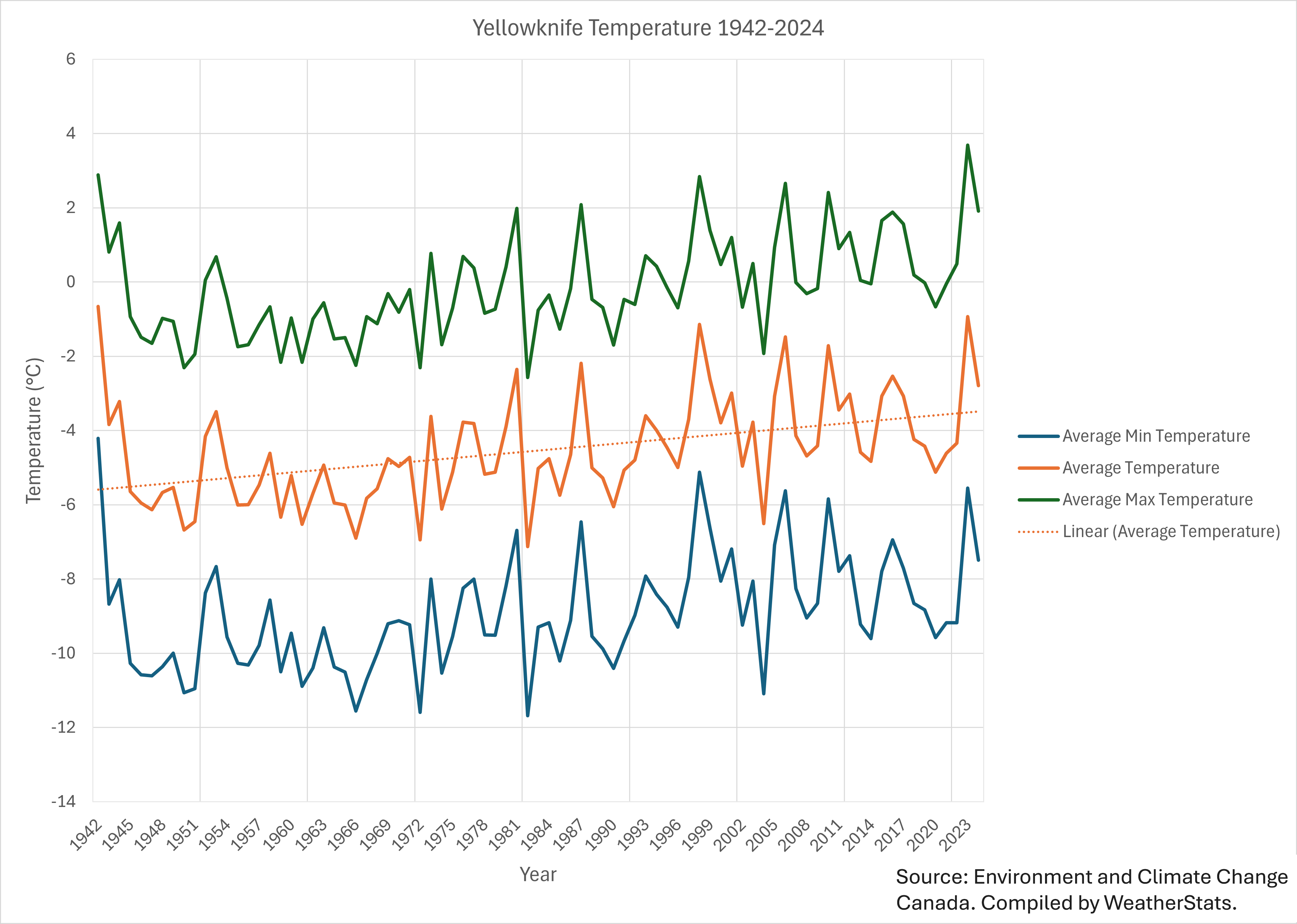Climate change is already happening in Yellowknife. We are experiencing higher average temperatures, changes in precipitation patterns, and warmer winters than in the last several decades. That’s why it is important that we strategically adapt to our changing climate.
What does 'adaptation' mean?
"Actions that help to prevent or reduce climate change impacts and leverage any benefits of a changing climate." - Canadian Climate Institute
Jump to section
Current climate Projected climate Current impacts How to adapt Climate justice
Current climate
Over the 82-year period of 1942 to 2024, Yellowknife warmed by 2.02 °C (see the gradually increasing average temperature line in the graph below). That number is still climbing.

Projected climate
In the coming years, Yellowknife is expected to see increasingly warmer and shorter winters, more precipitation in the form of snow, further permafrost degradation, hotter and drier summers, more intense wildfires, and more extreme weather among other climate hazards.
Climate Atlas of Canada – Climate Change Estimates for Yellowknife, 2051-2080:
|
Change |
1976-2005 Mean |
2051-2080 High-Carbon Climate Change Projections |
||
|
Low |
Mean |
High |
||
|
Typical Hottest Temperature |
28.7 |
29.0 |
32.2 |
36.4 |
|
Typical Coldest Temperature |
-43.6 |
-45.8 |
-37.3 |
-33.5 |
|
Number of -30oC Days/Year |
53 |
3 |
16 |
34 |
|
Number of below-zero days/year |
227 |
168 |
192 |
216 |
|
Number of +25oC Days/Year |
7 |
9 |
27 |
54 |
|
Annual Precipitation (mm) |
292 |
265 |
344 |
436 |
|
Frost-free season (days) |
111 |
121 |
144 |
166 |
Current impacts
Much of Yellowknife's building stock and infrastructure was designed to historical building standards and may be incompatible with our future climate. In the Northwest Territories, potential loss of infrastructure from permafrost thaw alone is estimated at $1.3 billion over the next 75 years – causing infrastructure damages of $51 million per year.
Climate change in Yellowknife is also:
- causing productivity losses and business disruptions (e.g., due to wildfire evacuations);
- affecting peoples’ physical and mental health (e.g., from forest fire smoke); and
- impacting the ecosystem and the services it provides (e.g., changes to wildlife and natural areas that impact hunting and gathering on the land).
Acting proactively can help us be better prepared for, and have increased capacity to respond to, the impacts of climate change. This will help prevent disruptions to our daily lives, service delivery, and economy, and keep our community members safe.
Prevention pays off!
According to the Canadian Climate Institute, even small investments to reduce vulnerability can deliver broad social, economic, and environmental benefits.
Decades of Canadian insurance payouts show that the number of catastrophic weather-related events is rising and that they’re becoming more costly. In July and August of 2024, extreme weather events resulted in $7 billion of insured losses in Canada– making that year the costliest in our country’s history.
Yellowknife has already begun to experience climate change impacts firsthand:
|
Community-wide evacuations |
|
| Infrastructure damage |
|
|
Disrupted services |
|
Check back soon to read the latest Climate Vulnerability Assessment here.
For more information on wildfires, prevention tips, and evacuation information, please visit the City’s Public Safety page.
How to adapt
What the City is doing (implemented or planned actions):
What residents can do:
*Possible for some tenants
|
Year-round |
|
| Summer & Fall |
|
| Winter & Spring |
|
What builders can do:
The Standards Council of Canada has created the Northern Infrastructure Standardization Initiative that consists of building standards to help northern communities adapt to climate change. The standards provide builders solutions for:
- Building in permafrost;
- Dealing with extreme weather; and
- Designing with climate change and risk in mind.
Climate justice
The City of Yellowknife recognizes that our residents are not affected equally by climate change, nor do they have equal access to resources to adapt to climate change impacts. We aim to improve equity in our community by advancing climate justice.
What does 'climate justice' mean?
It is an approach to addressing climate change that recognizes the existing inequities that are compounded by the disproportionate distribution of climate impacts on marginalized and vulnerable populations.
Stay tuned for the release of the 2026-2036 Climate Action Plan for more information on the City’s plan to advance climate justice.


